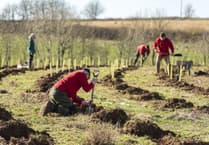THE MAN at the helm of Calstock’s neighbourhood plan vowed this week that the parish would fulfill its promise to the people to deliver ‘properly’ affordable homes following overwhelming support for the plan in last week’s referendum.
Speaking after 79% voted in favour of the Calstock Parish Neighbourhood Development Plan chairman Cllr Alastair Tinto said the people had given a clear mandate and now it was time to ‘make it happen.’
Bold proposals to reject any more new housing estates in preference to rural exception sites solely for affordable housing and infill housing within parish settlements had been hotly debated in the press and social media over the past few weeks.
And when polling day came last Thursday (January 20) more than a third of the population came out to cast their vote .
‘With a turnout of more than a third of the electorate it shows how passionate people are about their parish,’ said Mr Tinto. ‘The community could see that our plan supports local people having homes in the right place which will protect our beautiful countryside and unique characteristics of our villages. Over 79% people voted in favour of it which is a great result for the people of our parish,’
He said that the next task, when the dust settled, was to indentify housing associations who would be interested in rural exception sites and work with them and local landowners.
‘The housing issue has dominated the debate — and yes the plan is bigger than that, it tackles environmental issues, landscape, green energy and toursim — but there is no doubt housing is the central issue and now we are clear on what people want we can fulfill our promise to the electrate.
‘This plan was not about just getting it through and it sitting there, the community want affordable housing and we want to make it happen.’
‘We know it will be a challenge but we know it is imminently possible. There are rural exception sites in the parish already and Cornwall has the second largest number of affordable homes in the country.
Mr Tinto said that the county had sites of self build homes and socially rented housing and that was the vision for Calstock..
‘If you look at the Wainhomes development at St Ann’s Chapel that’s 140 or so homes and the number of affordable ones there is about six.
‘Also affordable seems to mean the top end of affordable — like 20% off the market price. When you think the average price of a property in Calstock now is £330,000, if you knock off 20% that is still way out of many people’s reach. What we need is council housing and properly affordable housing to buy.’
The plan’s chairman said the current agricultural land value for poor pasture was about £7,000 per acre. On rural exceptions sites, Cornwall Council expected that the value per housing plot would be £10,000.
‘So if a landowner made half an acre available for, say, seven houses he would get a return of £70,000 on that land as opposed to its £3,500 value as an half an acre of poor pasture,’ said Mr Tinto. ‘Rural exceptions sites therefore would enable landowners to get a reasonable return on small areas of land which would otherwise not be allowed for development.
‘Whilst our strategy is not to make a call for land just at the moment we would certainly be interested in talking to someone if they had a piece of land that could be used for this purpose.’
Calstock Parish Council chairman, Jim Wakem said: ‘I am delighted that the community has recognised the plan and all the policies within it. This wasn’t just a plan about housing developments but recognises the features of our parish that make it so special such as the Local Landscape and Heritage. It puts a real emphasis on protecting the environment with policies on Biodiversity, Sustainable (‘green’) Tourism and Renewable Energy. Moving forward, this council will look at identifying appropriate sites for affordable homes.’
The parish council expressed thanks to community members and councillors who worked on the neighbourhood development plan in particular Kate Latham and Glenys Rooker for their initial work on consulting with the community and drawing up the policies within the plan which were fine tuned after lots more community engagement.
Thanks were given to Steve Besford Foster for his sound advice and guidance and for all the people who cast their vote and have engaged with the council over the years.


.jpeg?width=209&height=140&crop=209:145,smart&quality=75)


Comments
This article has no comments yet. Be the first to leave a comment.